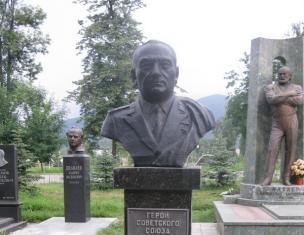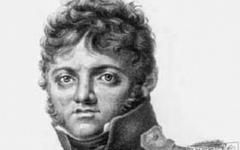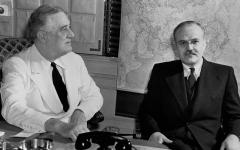Theme of the story: the fantastic and the real in depicting St. Petersburg reality with the help of satire.
The idea of the story: to force people to feel the vulgarity that surrounds them, since vulgarity has only one thought about itself, because it is unreasonable and limited and will not see or understand anything around except itself.
Characteristics of the main characters:
Kovalev is a collegiate assessor, “a man neither evil nor good,” all his thoughts are fixated on his own personality. This personality is invisible and he tries to embellish it. He talks about his acquaintances with influential people. Very preoccupied with worries about his appearance. How to stir up this person? Just put it in a marital status.
Ivan Yakovlevich, a barber, like every Russian artisan, “was a terrible drunkard,” unkempt.
The discovery of Kovalev's nose, which he shaved twice a week, left him numb with horror. He was neither alive nor dead. I had a hard time getting rid of my nose.
Impression of the book: at first it seems that this story is a joke. But there is some truth in every joke. Gossip, pettiness, arrogance - all this is vulgarity. Vulgarity has no kindness, nothing noble. Fantastic details enhance the satirical portrayal of St. Petersburg society and individual representatives, such as Major Kovalev.
Updated: 2017-10-24
Attention!
Thank you for your attention.
If you notice an error or typo, highlight the text and click Ctrl+Enter.
By doing so, you will provide invaluable benefits to the project and other readers.
Characters of N.V. Gogol's story "The Nose" and a short review. and got the best answer
Answer from Maxim Zulikov[guru]
well, the nose itself is gogol
Reply from Artem Zavadsky[guru]
Collegiate assessor Kovalev - a careerist who, for greater importance, calls himself a major - suddenly wakes up in the morning without a nose. Where the nose used to be is a completely smooth place. “Devil knows what, what rubbish! - he exclaims, spitting. “At least there was something instead of a nose, otherwise nothing!..” He goes to the chief police chief to report the loss, but on the way he unexpectedly meets his own nose in an embroidered gold uniform, a state councilor’s hat and a sword. Nose jumps into the carriage and heads to the Kazan Cathedral, where he prays devoutly. The amazed Kovalev follows him. Timidly, the collegiate assessor asks the nose to return, but he, with all the importance inherent in a conversation with a junior rank, declares that he does not understand what is being said and eludes the owner.
Kovalev goes to the newspaper to advertise his missing nose, but they refuse him, fearing that such a scandalous announcement will damage the publication’s reputation. Kovalev rushes to the private bailiff, but he, being out of sorts, only declares that a decent man’s nose won’t be torn off if he doesn’t hang around God knows where.
Heartbroken, Kovalev returns home, and then an unexpected joy occurs: a police official suddenly enters and brings in his nose wrapped in a piece of paper. According to him, the nose was intercepted on the way to Riga with a false passport. Kovalev rejoices immensely, but prematurely: the nose does not want to stick to its rightful place, and even the invited doctor cannot help. Only after many days the nose appears again in the morning on its owner’s face, just as inexplicably as it disappeared. And Kovalev’s life returns to normal.
Reply from Eee-eh! Great, mighty[guru]
The nose in the story symbolizes meaningless external decency, an image that, as it turns out, can well exist without any inner personality. And moreover, it turns out that an ordinary collegiate assessor has this image that is three ranks higher than the person himself, and flaunts in the uniform of a state councilor, and even with a sword. On the contrary, the unfortunate owner of the nose, having lost such an important detail of his appearance, turns out to be completely lost, because without a nose “... you will not appear in an official institution, in secular society, you will not walk along Nevsky Prospekt.” For Kovalev, who above all in life strives for a successful career, this is a tragedy. In “The Nose,” Gogol strives to show the image of an empty and pompous person who loves external showiness, chasing high status and the favor of higher ranks. He ridicules a society in which high position and rank are valued much more than the individual who possesses them.
Nikolai Gogol's story "The Nose" is one of the writer's most famous works. This absurdist story was written in 1832-1833.
Initially, the Moscow Observer magazine refused to print this work, and the author decided to publish it in the Sovremennik magazine. Gogol had to hear a lot of cruel criticism addressed to him, so the story was subjected to significant changes several times.
What is the story “The Nose” about?
The story “The Nose” consists of three parts and tells about an incredible incident that happened to the collegiate assessor Kovalev. “The Nose” begins with the fact that one morning a St. Petersburg barber discovers that there is a nose in his bread, and subsequently realizes that this nose belongs to his client, Major Kovalev. All subsequent time, the barber tries by any possible means to get rid of his nose, but it turns out that he constantly drops his unfortunate nose and everyone around him constantly points this out to him. The barber was able to get rid of it only when he threw it into the Neva.
Meanwhile, Kovalev, who has woken up, discovers that his own nose is missing, and somehow covering his face, he goes in search of it. Gogol shows us how the collegiate assessor diligently searches for his nose throughout St. Petersburg, and his feverish thoughts about how terrible it is to be in such a situation and not be able to appear before the people he knows. And when Kovalev finally meets his nose, he simply does not pay attention to him, and no requests from the major for his return to his place have any effect on the nose.
The main character tries to submit an advertisement about his missing nose to the newspaper, but the editorial office refuses him due to the fact that such a fantastic situation could harm the reputation of the newspaper. Kovalev even sends a letter to his friend Podtochina, accusing her of stealing his nose in retaliation for his refusal to marry her daughter. In the end, the police supervisor brings the nose to its owner and tells him how hard it is to catch the nose, which was about to go to Riga. After the warden leaves, the main character tries to put his nose back in place, but he fails. And then Kovalev falls into terrible despair, he realizes that life is now meaningless, since without a nose he is nothing.
Position of a person in society
It was the absurdity and fantastic nature of the plot that caused such abundant criticism of the writer. But it should be understood that this story has a double meaning, and Gogol’s idea is much deeper and more instructive than it seems at first glance. It is thanks to such an incredible plot that Gogol manages to draw attention to an important topic at that time - the position of a person in society, his status and the dependence of the individual on him. From the story it becomes clear that the collegiate assessor Kovalev, who for greater importance called himself a major, devotes his entire life to his career and social status, he has no other hopes and priorities.
Kovalev is losing his nose - something that, it would seem, cannot be lost for no apparent reason - and now he cannot appear in a decent place, in secular society, at work or in any other official institution. But he cannot come to an agreement with the nose; the nose pretends that it does not understand what its owner is talking about and ignores him. With this fantastic plot, Gogol wants to emphasize the shortcomings of the society of that time, the shortcomings of thinking and consciousness of that layer of society to which the collegiate assessor Kovalev belonged.
Gogol's "Petersburg Tales" have enjoyed constant popularity among the reading public since its publication. But for those who do not want to plunge into the atmosphere of Gogol’s Petersburg or simply do not have time for this, we suggest reading a summary. Gogol, "The Nose". Let's try to convey the special mood of this work.
Chapter 1. The hairdresser and the major's nose
The story begins with the hairdresser Ivan Yakovlevich waking up at home and getting ready to have breakfast. Thinking about whether he should drink coffee or maybe eat some bread and onions. Ivan Yakovlevich is forced to choose, since his wife’s nature is such that she does not allow her husband to eat a sandwich with onions and wash it down with hot coffee. The hero stops at the bread and onions, cuts them, and then discovers the nose of the collegiate assessor Kovalev (he preferred to be called major). This is the summary from the very beginning. Gogol wrote “The Nose” in such a way that it intrigues the reader from the first lines.
Ivan Yakovlevich feels sick. In addition, the wife, seeing the nose, begins to shout at him and demand that he throw this abomination out of the house.

Despite the fact that the character in the first chapter was a barber, he looks unkempt: there are not enough buttons on his clothes, and the man himself was always unshaven and hungover. And it was in this usual form that he trudged away from the house to fulfill his wife’s orders.
But luck did not favor the hero, for he walked a lot, but never found a suitable place to get rid of his nose. He was constantly distracted by familiar people. And so he finds himself at the St. Isaac's Bridge and, having thrown his ill-fated find from it, expects to go about his business. But he is detained by the quarterly supervisor. The summary stops here. Gogol created “The Nose” in such a way that the main action of this story is transferred to the second chapter.
Chapter 2. The major's search for his nose
On the morning of the same day, when the barber discovered his nose in his bread, Major Kovalev did not find it. He wanted to look at the pimple that had popped up earlier, but neither the pimple nor the nose was there, and instead there was only a flat surface. Despite the creepiness of everything that happens (which is what the summary tells), Gogol’s “The Nose” generously flavors it with the author’s unique humor.
Of course, Kovalev, like any person, was terribly frightened and immediately ran to the chief police chief, and already leaving him (the major did not find the peace officer), he sees how his own nose gets into the carriage and goes to the Kazan Cathedral for the service. The main thing is that the hero’s nose is dressed in the outfit of a state councilor, i.e. he is higher in rank than the owner. Kovalev followed part of his body into the cathedral, where he tried to timidly speak to him, but his nose stopped all communication, saying that they were absolutely not acquainted with him. The discouraged hero leaves the church. Gogol wrote “The Nose” (the summary, we hope this makes you feel it) in such a way that the plot maintains intrigue until the last chapter.

Wandering around the city in search of a solution, Kovalev wanders into a newspaper, where he begs to publish an advertisement about his missing nose, but he is refused under various plausible pretexts, citing the rules of decency, they say, it is inappropriate to publish any nonsense in decent printed publications.
Kovalev returns home in despair. He thinks about who and, most importantly, how they were able to steal his nose. A version emerges: staff officer Podtochina took revenge and brought the healers on him in revenge for the fact that he did not want to marry her daughter.
The hero's sad thoughts are interrupted by the appearance of a police major in the house of a police major. He informs the owner: his nose with a fake passport was intercepted. Apparently, he intended to leave for Riga. Kovalev was beside himself with happiness and even gave money to the campaigner. And it seemed that Gogol’s “The Nose” (the summary would also have ended) could end here, but this is not the end of the story.
As it turns out later, it is too early to rejoice: the nose does not want to return to its original place. Kovalev even calls the doctor, but Tom can’t help, he just asks to sell his nose for experiments. True, the doctor says that he will buy this amazing anatomical specimen only for a reasonable price. Kovalev says in a rage: “I won’t sell it for anything.” The hero again returns to the version of damage and even writes a letter to the lady indicated above (Podtochina). True, nothing comes of this, since she answers in such a spirit that there can be no doubt, Kovalev’s fears are in vain. This is not witchcraft. N.V. Gogol wrote “The Nose” (the summary proves this) in such a way as to make it clear: the main character is experiencing serious suffering.
Rumors

Meanwhile, rumors are spreading throughout St. Petersburg that in one place or another a nose is seen walking on its own. Some daring people even make money from this, but the crowd that gathers here and there does not have the honor of seeing any nose independently walking through the streets of the city.
Chapter 3. The nose returns home
One way or another, two weeks after the start of the story, the nose returns to its original place. And it must be said that the absence of a very important part of the face only benefited the major. He is friendly and nice to everyone. In other words, “quiet and quiet - God’s grace.”
Gogol's story "The Nose" (the summary does not contain this part) ends with an afterword by the author, which, although funny, is no longer directly related to the matter.
The story "The Nose" is one of the most fun, original, fantastic and unexpected works of Nikolai Gogol. The author did not agree to publish this joke for a long time, but his friends persuaded him. The story was first published in the Sovremennik magazine in 1836, with a note by A.S. Pushkin. Since then, heated debates have not subsided around this work. The real and the fantastic in Gogol's story "The Nose" are combined in the most bizarre and unusual forms. Here the author reached the pinnacle of his satirical skill and painted a true picture of the morals of his time.
Brilliant grotesque
This is one of N.V.’s favorite literary devices. Gogol. But if in early works it was used to create an atmosphere of mystery and mystery in the narrative, then in a later period it turned into a way of satirically reflecting the surrounding reality. The story "The Nose" is a clear confirmation of this. The inexplicable and strange disappearance of the nose from Major Kovalev’s face and his incredible independent existence separately from his owner suggest the unnaturalness of the order in which a high status in society means much more than the person himself. In this state of affairs, any inanimate object can suddenly acquire significance and weight if it acquires the proper rank. This is the main problem of the story "The Nose".

Features of realistic grotesque
In the late work of N.V. Gogol is dominated by realistic grotesque. It is aimed at revealing the unnaturalness and absurdity of reality. Incredible things happen to the heroes of the work, but they help to reveal the typical features of the world around them, to reveal the dependence of people on generally accepted conventions and norms.
Gogol's contemporaries did not immediately appreciate the writer's satirical talent. Only having done a lot for a correct understanding of Nikolai Vasilyevich’s work, he once noticed that the “ugly grotesque” that he uses in his work contains “an abyss of poetry” and “an abyss of philosophy”, worthy of “Shakespeare’s brush” in its depth and authenticity.
“The Nose” begins with the fact that on March 25, an “extraordinarily strange incident” happened in St. Petersburg. Ivan Yakovlevich, a barber, discovers his nose in freshly baked bread in the morning. He throws him off the St. Isaac's Bridge into the river. The owner of the nose, the collegiate assessor, or major, Kovalev, waking up in the morning, does not find an important part of the body on his face. In search of the loss, he goes to the police. On the way he meets his own nose in the garb of a state councilor. Pursuing the fugitive, Kovalev follows him to the Kazan Cathedral. He tries to return his nose to its place, but he only prays with “the greatest zeal” and points out to the owner that there can be nothing in common between them: Kovalev serves in another department.
Distracted by an elegant lady, the major loses sight of the rebellious part of the body. After making several unsuccessful attempts to find the nose, the owner returns home. There they return what was lost to him. The police chief grabbed his nose while trying to escape using someone else's documents to Riga. Kovalev's joy does not last long. He cannot put the body part back in its original place. The summary of the story "The Nose" does not end there. How did the hero manage to get out of this situation? The doctor can't help the major. Meanwhile, curious rumors are creeping around the capital. Someone saw the nose on Nevsky Prospekt, someone saw it on Nevsky Prospect. As a result, he himself returned to his original place on April 7, which brought considerable joy to the owner.

Theme of the work
So what is the point of such an incredible plot? The main theme of Gogol's story "The Nose" is the character's loss of a piece of his self. This probably happens under the influence of evil spirits. The organizing role in the plot is given to the motive of persecution, although Gogol does not indicate the specific embodiment of supernatural power. The mystery captivates readers literally from the first sentence of the work, it is constantly reminded of it, it reaches its climax... but there is no solution even in the finale. Covered in the darkness of the unknown is not only the mysterious separation of the nose from the body, but also how he could exist independently, and even in the status of a high-ranking official. Thus, the real and the fantastic in Gogol’s story “The Nose” are intertwined in the most unimaginable way.

Real plan
It is embodied in the work in the form of rumors, which the author constantly mentions. This is gossip that the nose regularly promenades along Nevsky Prospect and other crowded places; that he seemed to be looking into the store and so on. Why did Gogol need this form of communication? Maintaining an atmosphere of mystery, he satirically ridicules the authors of stupid rumors and naive belief in incredible miracles.
Characteristics of the main character
Why did Major Kovalev deserve such attention from supernatural forces? The answer lies in the content of the story "The Nose". The fact is that the main character of the work is a desperate careerist, ready to do anything for a promotion. He managed to receive the rank of collegiate assessor without an exam, thanks to his service in the Caucasus. Kovalev’s cherished goal is to marry profitably and become a high-ranking official. In the meantime, in order to give himself more weight and significance, he everywhere calls himself not a collegiate assessor, but a major, knowing about the superiority of military ranks over civilian ones. “He could forgive everything that was said about himself, but he did not forgive in any way if it related to rank or title,” the author writes about his hero.
So the evil spirit laughed at Kovalev, not only taking away an important part of his body (you can’t make a career without it!), but also endowing the latter with the rank of general, that is, giving it more weight than the owner himself. That's right, there is nothing Real and fantastic in Gogol's story "The Nose" makes you think about the question "what is more important - the personality or its status?" And the answer is disappointing...

Hints from a brilliant author
Gogol's story contains many satirical subtleties and transparent hints at the realities of his contemporary time. For example, in the first half of the 19th century, glasses were considered an anomaly, giving the appearance of an officer or official some inferiority. In order to wear this accessory, special permission was required. If the heroes of the work strictly followed the instructions and corresponded to the form, then the Nose in the Uniform acquired for them the importance of a significant person. But as soon as the police chief “logged out” of the system, broke the strictness of his uniform and put on glasses, he immediately noticed that in front of him was just a nose - a part of the body, useless without its owner. This is how the real and the fantastic intertwine in Gogol’s story “The Nose”. No wonder the author’s contemporaries were engrossed in this extraordinary work.

Many writers noted that “The Nose” is a magnificent example of fantasy, Gogol’s parody of various prejudices and people’s naive belief in the power of supernatural forces. Fantastic elements in the works of Nikolai Vasilyevich are ways of satirically displaying the vices of society, as well as affirming the realistic principle in life.








